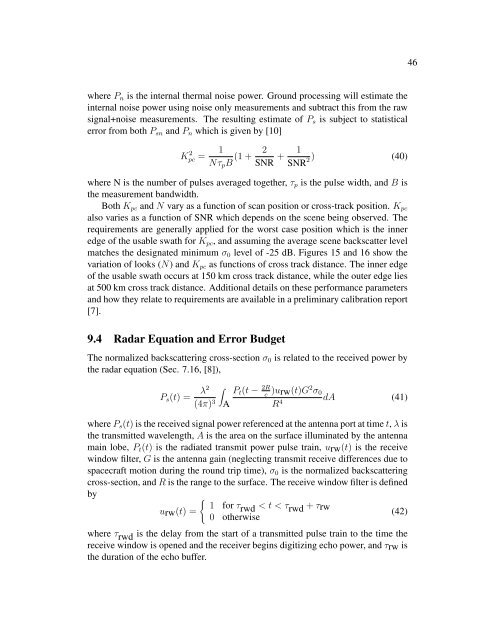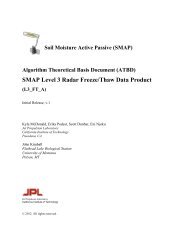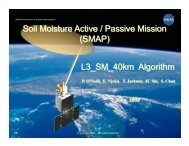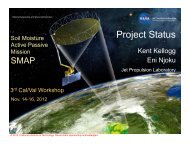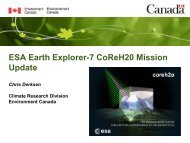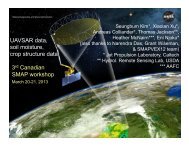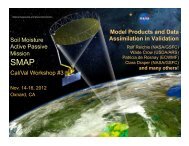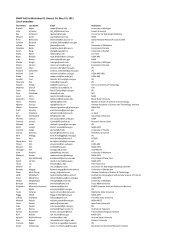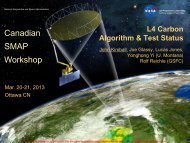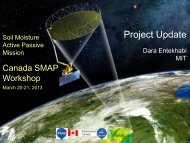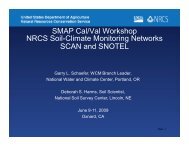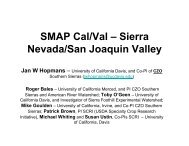(ATBD) SMAP Level 1 Radar Data Products - NASA
(ATBD) SMAP Level 1 Radar Data Products - NASA
(ATBD) SMAP Level 1 Radar Data Products - NASA
Create successful ePaper yourself
Turn your PDF publications into a flip-book with our unique Google optimized e-Paper software.
46<br />
where P n is the internal thermal noise power. Ground processing will estimate the<br />
internal noise power using noise only measurements and subtract this from the raw<br />
signal+noise measurements. The resulting estimate of P s is subject to statistical<br />
error from both P sn and P n which is given by [10]<br />
K 2 pc = 1<br />
Nτ p B (1 + 2<br />
SNR + 1<br />
SNR 2 ) (40)<br />
where N is the number of pulses averaged together, τ p is the pulse width, and B is<br />
the measurement bandwidth.<br />
Both K pc and N vary as a function of scan position or cross-track position. K pc<br />
also varies as a function of SNR which depends on the scene being observed. The<br />
requirements are generally applied for the worst case position which is the inner<br />
edge of the usable swath for K pc , and assuming the average scene backscatter level<br />
matches the designated minimum σ 0 level of -25 dB. Figures 15 and 16 show the<br />
variation of looks (N) and K pc as functions of cross track distance. The inner edge<br />
of the usable swath occurs at 150 km cross track distance, while the outer edge lies<br />
at 500 km cross track distance. Additional details on these performance parameters<br />
and how they relate to requirements are available in a preliminary calibration report<br />
[7].<br />
9.4 <strong>Radar</strong> Equation and Error Budget<br />
The normalized backscattering cross-section σ 0 is related to the received power by<br />
the radar equation (Sec. 7.16, [8]),<br />
P s (t) =<br />
λ2 P t (t −<br />
(4π)<br />
∫A<br />
2R)u c rw(t)G 2 σ 0<br />
dA (41)<br />
3 R 4<br />
where P s (t) is the received signal power referenced at the antenna port at time t, λ is<br />
the transmitted wavelength, A is the area on the surface illuminated by the antenna<br />
main lobe, P t (t) is the radiated transmit power pulse train, urw(t) is the receive<br />
window filter, G is the antenna gain (neglecting transmit receive differences due to<br />
spacecraft motion during the round trip time), σ 0 is the normalized backscattering<br />
cross-section, and R is the range to the surface. The receive window filter is defined<br />
by<br />
{<br />
1 for τrwd < t < τ<br />
urw(t) =<br />
rwd + τrw<br />
(42)<br />
0 otherwise<br />
where τ rwd is the delay from the start of a transmitted pulse train to the time the<br />
receive window is opened and the receiver begins digitizing echo power, and τrw is<br />
the duration of the echo buffer.


